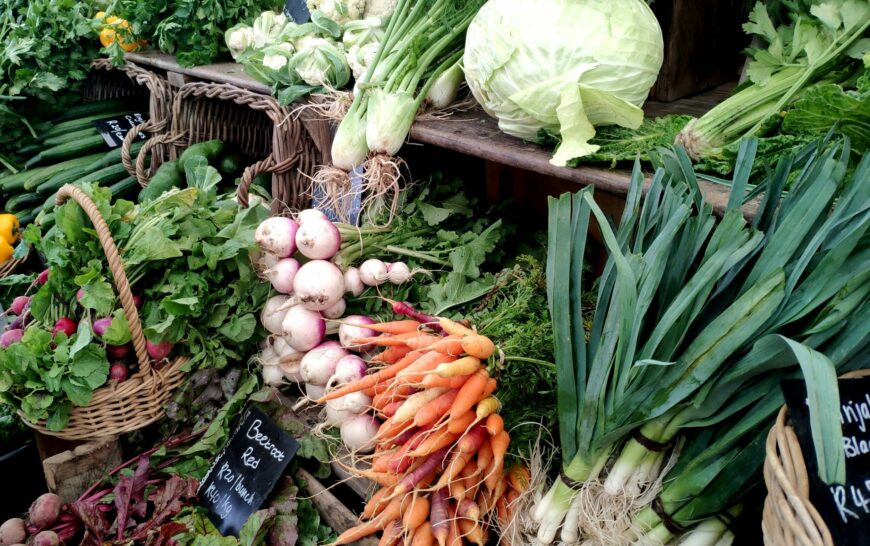
A Beginner’s Guide to Seasonal Eating
By being mindful with your food choices, you’ll also be reaping the benefits of a varied diet and getting a whole bunch of vitamins and minerals that you’d otherwise be missing out on, free of the pesticides and fertilisers used to force the produce to grow all year round.
Doing our bit for the planet doesn’t always have to mean a complete lifestyle overhaul. It can be as simple as going meat-free twice a week or cultivating mindful shopping habits such as making an effort to buy home-grown produce.
By eating with the seasons as nature intended, you can support your local economy and reduce your carbon emissions by almost a tonne a year, that’s equivalent to a return flight from London to Boston. And the climate isn’t the only one to benefit from eating seasonally. Syncing up with mother nature’s calendar is also kinder to your gut health and your wallet – it’s a win-win.
When fruit and veg in season, it’s abundant which drives the cost down. So, whilst you might fancy eating blueberries with your porridge in the colder months, you’ll have to fork out to enjoy those out-of-season antioxidants. Eating with the seasons *saves* money. Fact.
Only 23% of the fruit and veg eaten in Britain is grown here meaning the rest is imported, and flying our five a day overseas is unsurprisingly a spenny business. Fruit and veg shipped from the other side of the world can lose vitamins and minerals in transportation and storage so by eating fresh produce picked at its peak, you’ll be getting the most out of your fruit and veg and reducing your environmental impact whilst you’re at it since the food hasn’t had to travel as far to get to you.
By being mindful with your food choices, you’ll also be reaping the benefits of a varied diet and getting a whole bunch of vitamins and minerals that you’d otherwise be missing out on, free of the pesticides and fertilisers used to force the produce to grow all year round.


What is eating seasonally and how do you do it?
The concept of eating seasonally involves reconnecting with nature’s rhythms and only eating what’s readily available to harvest locally right now. This means you’ll be benefiting from fresh produce grown in natural conditions and packed full of flavour: no artificial hothouses and fewer carbon emissions, just maximum taste with minimal environmental impact!
While it’s easy to grab whatever you fancy from the 24-hour supermarket all year round – blackberries in spring, asparagus in autumn, strawbs in winter – it means we’ve got used to having whatever food we want at any time, causing a disconnect with what’s in season and what’s not. Eating seasonally and locally is a great way to get back in touch with our intuitive hunter gatherer roots.
Tips for eating seasonally
Look at the labels
When shopping in-store, check supermarket labels for the country of origin to help make informed choices about what you’re buying.
Visit your local farmer’s market
Shopping at your local farmer’s market not only means you’re doing your bit for the local economy and the climate but you’ll be getting produce that’s been picked at its very best. It’s also an opportunity to ask questions and find out what processes have been used to grow and harvest your food, cultivating a better connection with what we’re eating.
Mooching around the farmer’s market just so happens to coincide rather nicely with hopping between independent food stalls, grazing *all day* and falling into a nearby country pub for dessert. Here. For. It.
Consider giving wonky fruit & veg a good home
No doubt you’ve heard of rescuing dogs but have you ever heard of rescuing a wonky parsnip and a curvy cucumber?
Unfortunately, our food system prizes good looks over taste and sustainability, meaning a lot of perfectly nutritious food goes to waste because it isn’t pretty enough for supermarket beauty standards. In the UK alone, 3 million tonnes of fruit and veg goes to waste before it even leaves the farm.
By rescuing a box of unwanted fruit and veg, you can make a positive impact on the environment, reduce waste and enjoy an abundance of fresh ‘n’ tasty produce while you’re at it.
Oddbox is one such business fighting the battle against food waste and unnecessary retailer cosmetic requirements. They work directly with farmers and growers to see what they’ve got going spare and deliver them straight to your home or office overnight (less traffic on the road = lower carbon emissions, they’ve thought of everything). You can choose from low waste small, medium and large fruit and veg boxes, all made from minimal packaging.
For build-your-own boxes and 100% organic or sustainably wild produce, try Abel & Cole. From sustainable fish, organic meat and household staples, they’re committed to putting the planet first and supporting independent growers.
Grow your own
You don’t need to be the next Monty Don to have a go at growing your own balcony herb garden or windowsill veg plots.
From watercress to kale, garlic, chillies, radishes, toms, carrots, chives, micro greens and edible flowers, you can’t get more local than your own windowsill.


What to eat and when
This handy list of food by the seasons is a great point of reference if ever you’re wondering what to eat when.
The Deliciously Ella app is also a great resource for seasonal recipes and ideas on what to make with your greengrocer haul.
*Spring*
Asparagus | Carrots | Cauliflowers | Cucumbers | Curly Kale | Savoy Cabbage | Spinach | Spring Onion | Watercress | Wild nettles | Purple sprouting broccoli | Gooseberries | Rhubarb | Lamb
Crab | Lobster | Mackerel | Prawns | Sea bass | Trout | Haddock
*Summer*
Beetroot | Broad beans | Carrots | Cauliflowers | Courgettes | Cucumber | Fennel | Peas | Garlic | Green beans | New potatoes | Lettuce & salad leaves | Radishes | Sage | Runner beans | Salad onions | Squash | Tomatoes | Watercress | Blueberries | Currants | Elderflower berries | Figs | Plums | Raspberries | Strawberries
Crab | Wild salmon | Pilchards
*Autumn*
Field mushrooms | Lettuce | Marrow | Potatoes | Pumpkin | Rocket | Sweetcorn | Watercress | Apples | Blackberries | Damsons | Elderberries | Pears | Plums | Sloes
Grouse | Venison | Oysters | Skate | Brill | Dover Sole
*Winter*
Brussels sprouts | Cabbage | Carrots | Cauliflower | Celeriac | Curly kale | Fennel | Leeks | Parsnips | Potatoes | Red cabbage | Swede | Turnips | Apples | Pears | Quince
Venison | Goose | Partridge | Pheasant | Wild duck | Turkey | Mussels | Scallops




